- Event Weeks
- Road Weather Event Week 2019
Road Weather Event Week 2019
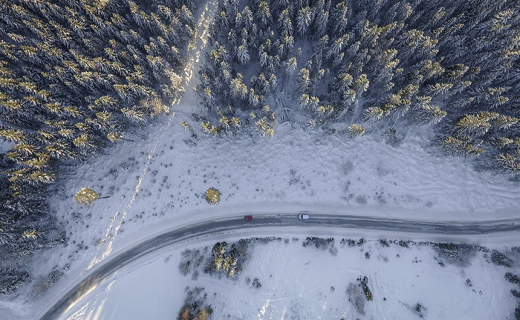
From 9 till 13 December 2019 EuMeTrain organized an Event Week about Road Weather. Several road weather related topics were addressed during the event week and the main weight of the event was on winter weather. The target audience were operational meteorologist but also researchers and developers.
The Event Week was fully virtual, which means the presentations were done online using the Webex software.
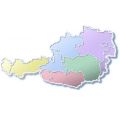
Session 1: 9 December 2019
During winter season we have a lot of additional products dealing with road weather, especially road conditions (snow, ice, hoarfrost,...). The talk will give a short overview about our special products, what are the differences to a normal forecast and point out some problems in forecasting special parameters in the alpine region. Additionally you will get some information about our special training services for road maintainance workers and also you will get a short overview about our internet portal, which we provide for our customers.
One of the greatest difficulties facing forecasters during the cool season is the correct determination of precipitation type, especially with temperatures close to freezing point. There are numerous sources of uncertainty in precipitation type forecasts which is why mixed phases are not well predicted. These uncertainties are difficult to reduce but can potentially be quantified by the use of ensembles.
The Integrated Forecast System (IFS) ensemble forecasts (ENS) from ECMWF provide an instantaneous precipitation type (ptype) output variable that describes 6 types of precipitation at the surface: rain, freezing rain, snow, wet snow, sleet or ice pellets (plus dry). As part of ECMWF's contribution to the ANYWHERE European project, two new products were developed. These are the most probable precipitation type, shown on map format, and the instantaneous probabilities of different types, shown for a given site. The first of these shows which type is most probable whenever the probability of some precipitation is >50%. The second product depicts the temporal evolution of probabilities for a specific location in bar chart format, classified also according to three categories of instantaneous precipitation rate. These new instantaneous probabilistic products will be shown through an experiment reproducing the freezing rain case study in Slovenia in 2014.

Session 2: 9 December 2019
Climate change is almost literally the “hot” topic of today. Scientists agree that cars with combustion engines are one of the main sources of greenhouse gasses, however, with such vastly growing world economy, transportation of goods and people is essential. Thus, certain measures must be and are being made to reduce their negative effect on climate.
Humanity has reached a point in time, when even if greenhouse gas emissions could be reduced to pre-industrial times it will not stop the human-induced climate change and the effects of it will be felt for decades or even centuries to come. Therefore, we’re compelled to know and understand what to expect from road weather, especially in winter seasons.
In this session, the problem of lack of specific climate forecasts for winter road weather will be discussed and future climate projections for road weather patterns will be presented with Lithuania as an example. The study in question involved regular climate forecasts for 21st century for several RCPs, downscaling of data to fit Lithuania and formation several statistical indices, that better describe road weather for road maintenance workers and road users. Using the indices allows a better understanding on what’s to come and how climate change will impact road weather in the 21st century.

Session 3: 10 December 2019
Driving and road weather in Norway can be demanding all year around, not just because of the subarctic location, but also because of the complex terrain, from deep fjords to high mountains. The Norwegian Meteorological Institute have recently upgraded its road weather warning system, focusing on precipitation and wind.
The lecture will give a short overview about how the German weather service support land transport service. Main focus is to show results of the new backend containing MOS trained weather forecasts at the 1500 German Street Weather Stations (SWS) and forecasts of the street model METRo at this stations. Results will be presented at a Frontend system which will be replaced by a new modern system as well as the new Backend System.
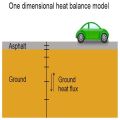
Session 4: 10 December 2019
Finnish Meteorological Institute’s (FMI) road weather model has been in operational use for almost 20 years. The main outputs of the model are road surface temperature and amounts of water, snow and ice on the road. Based on these values, the model determines also the road condition (e.g. wet, icy or snowy), calculates friction and gives index for overall driving conditions (normal, difficult, very difficult). The forecasts help in the road maintenance decision making and give useful information to the road users about the driving conditions. In the actual forecast phase, the input is obtained from forecast edited by duty meteorologist.
There are several things that know about the model behavior. For example, the model is very dependent of the driving forecast. The typical errors in the input data will also present themselves in the road weather forecast. In addition, the present model assumes open sky conditions and doesn't take into account the openness of the surroundings. This can cause error to the forecasts for example in forested areas. The model aims to improve the first forecast hours by utilizing a method called coupling. This correction is used during the forecast phase so that its effect reduces as the forecast advances. Although coupling improves the forecast in average, in some situations it might not work as intended.
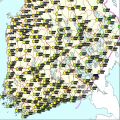
Session 5: 11 December 2019
FMI provides road weather forecasts for all road maintenance companies in Finland that provide maintenance operations for the state. The service is defined by the Finnish Transport Agency, which services and products are included and what are the ways they are delivered. Addition to this FMI has had a long Public-Private-Partnership (PPP) with the biggest maintenance company in Finland called Destia. At FMI's weather center Destia's road maintenance supervisors have worked side by side with FMI's meteorologists for 17 winters. This procedure has been found fruitful for both parties so that we can support each other on road weather related issues. FMI has developed several applications by itself and together with Destia to help operating the maintenance work.
The Finnish Meteorological Institute (FMI) has developed a numerical weather model that simulates the level of slipperiness on the sidewalks. The model classifies the expected sidewalk slipperiness into three classes; normal, slippery and very slippery. Normal means that there is not ice or snow on the surface. FMI is giving warnings if very slippery sidewalk condition is expected. During very slippery sidewalk condition normal walking is difficult for everyone and extra attention must be paid off when walking.
Icy and snowy sidewalks are very typical phenomena in Finland during winter. Slipperiness due to ice and snow on sidewalks increases the risk of pedestrians' injuries. Almost every second person slips annually in Finland and around 50 000 persons (1 % of Finnish population) are injured and need medical attention. Slip injuries are a big problem causing economic losses and long sick leaves. Emergency departments are crowded during the most slippery days.
FMI's warnings for slippery pedestrians' sidewalk condition is one way to improve the safety among the pedestrians and add awareness of slipperiness. Pedestrians may reserve more time for travelling, choose the way of travelling or use anti-slip devices if very slippery pavement condition is forecasted.
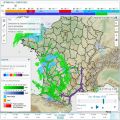
Session 6 - 17 September 2020
During winter, snow or ice presence on the road might have serious consequences on road traffic and security and many efforts were done for several years to develop decision-making tools for road management in winter. For this purpose, Météo-France uses, in an operational way a specific system dedicated to the road weatherforecast.
The first one, OPTIMA is a high-frequency (5 min) nowcasting system providing 1 hour forecasting and based on data fusion approach. It is dedicated to real time and short range anticipation of road impacting phenomenon. It was specially developed to work at the road network resolution (5km).
The data OPTIMA uses for the forecast process:
- Radar observation and nowcasting
- Surface observation network and road weather stations observations from customers
- Best available weather forecast (i.e. expertized by human forecasters)
- Specific road weather forecast
As an input for this decision-making tool, Météo-France uses numerical road models, which permit to simulate the behavior of a road under the influence of atmospheric conditions and the behavior of the snow on the road. Since 2012, road models are forced by human expertized atmospheric forecast instead of a direct coupling with numerical weather prediction models. Thissystems, called PEIR (Expertise Predictions for ISBA-Route), are the basis of road conditions forecasting products for French road managers.
Since the beginning of operational road weather forecast in Météo-France, all the products were based on deterministic forecasts, however since 2018/2019 winter, a new approach is tested, based on ensemble forecast.
Recording Ludovic Bouilloud, Odile Coudert and Christine Bruschi
Freezing rain is a relatively complex phenomenon, with rare occurrence but often related to serious damages and threats. With only few tools available, it has always been a strong challenge for the operational forecasters - in terms of appearance, intensity and impacts. Croatia - as well as Slovenia and Hungary - experienced an extreme and disastrous event in winter 2014, with several hundreds million Euro damage, and temporal collapse of the traffic and energy system.
This paper presents recent developments and experiences in freezing rain operational forecasting. A major tool used recently is the new 'precipitation type' product provided by ECMWF, and so far with overall very good performance. It is accompanied by other diagnostic tools defined in the Croatian Hydrological and Meteorological Service. Several recent cases will be presented, and experiences and forecast performance will be discussed.
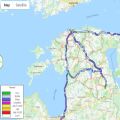
Session 7: 12 December 2019
Since 2016 Teede Tehnokeskus, the state owned road research and consultancy company provides winter road weather information service together with the Estonian Environment Agency (EEA) for all national roads, maintenance companies and Estonian Road Administration. The main service providing tool is a TIK web service https://tik.teeilm.ee/en which includes all essential information for decision making.
Beside the official road weather forecast provided by EEA the service includes also alternative road weather forecasts which are based on regional weather models from Finland, Sweden and Norway and Teede Tehnokeskus own METRo origin road weather model. These four models have been in operation for three winters and a special tool for model comparison and verification has been developed. The presentation gives an overview of the system's architecture and highlights some experiences in integration of Open Data of different sources and createsnew value in relatively large scale.

Session 8: 13 December 2019
Forecasting the conditions of roads and highways is important for traffic safety and road maintenance (salting, clearing snow) decision making in Belgium. The Royal Meteorological Institute of Belgium (RMI) collaborated with the Royal Netherlands Meteorological Institute (KNMI) to adapt the KNMI road weather model for Belgian roads. It is based on a 1D radiative transfer model that makes use of meteorological input from different numerical weather prediction models and the INCA-BE nowcasting model used by the RMI weather office. The output (road surface temperature and condition) is generated for about 90 road weather station locations in Flanders and 50 in Wallonia, and is visualized through a GIS interface. We present our operational "GMS system", which gives forecasts every hour, and is available through a web platform for the regional traffic agencies in Flanders and Wallonia. After that, we give a brief introduction to the SARWS project, which RMI participates in with other Belgian partners. Crowd-sourced data is increasingly used in weather science, and road forecasting is no exception. One of the aims of the SARWS project is measuring several weather parameters in real-time from vehicle sensors, in order to enhance the RMI road weather forecasts performed, and eventually send warnings to drivers in case of dangerous conditions. In the presentation, we will highlight the first results of a field test performed by three cars in the region of Antwerp.
Recording Joris Van den Bergh and Sylvain Watelet
Winter weather in Iceland is severe on any scale. Strong winds, deep synoptic cyclones, blizzards and avalanche risk are conditions that happen every year. The island of Iceland is mountainous and to from one part of the country to another travellers have to cross at least one, and often several mountain passages or drive on roads where steep and high mountains and complex terrain control the winds.
The Icelandic Meteorological Office (IMO) does not do specific road weather forecasts but regular forecasts for all parts of Iceland as well as impact based warnings, where societal impact, including impact on traffic is a part of the evaluation process. In this session I will introduce the use of high resolution limited area models, SOT and EFI products and specific risk products such as snow drift models based on the Harmonie Arome model.
